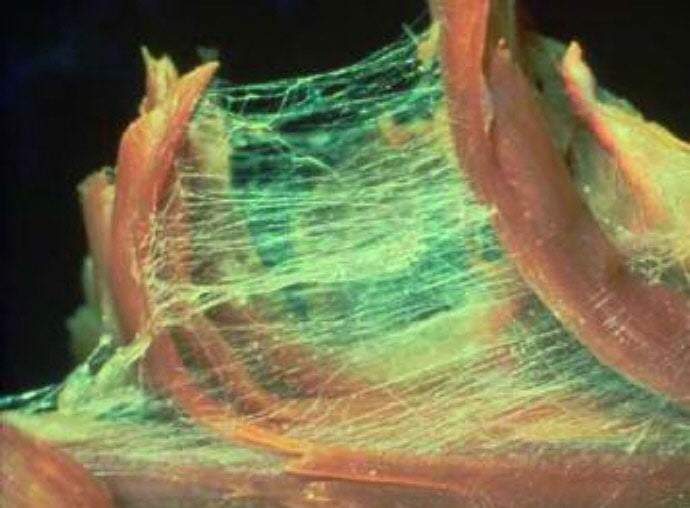Have you every thought about what really holds your horse’s body together? Is it their skin? Skeleton?
Your horses’ “birthday suit” is actually made up of a web of connective tissue called Fascia.
Fascia has been receiving a great deal of attention recently, and rightfully so. For hundreds of years it has been described as a “passive structure” but is now known to actively contract in a smooth-muscle like manner, thereby influencing the dynamics of the musculoskeletal system. The influence fascia plays on posture and movement is being extensively researched in the human field, thanks to people like Thomas Myers. Myers, an American myofascial specialist has shown that this connective tissue presents itself as a whole body system, and not 600 separate muscles. He describes the body as having only “one muscle, hanging out in 600 or more fascial pockets.”
Veterinarian, Dr. Vibeke Sødring Elbrønd has discovered through autopsy that the equine has the same kind of chains and connective tissue networks through the body, as found in humans by Myers. Since the horse is a quadruped, these lines, known as myofascial chains, are 90% consistent with those in humans.
So what is it and what does it do?
Fascia is a continuous web that surrounds and separates, supports and protects the body whilst still allowing it to move freely.
This web, or system is composed of collagen, elastin and a ground substance, which is a thin, jelly-like substance and is not dissimilar to a spider’s web in that it is incredibly strong. Collagen provides strength and shape whilst elastin allows for stretch and shock absorption. Some folk have estimated that Fascia is able to withstand over 900kg per square inch. This is pretty incredible when you think about what Fascia looks like. You may have seen it when looking at an open wound or when you lift the skin on a piece of raw chicken. It’s a thin, smooth slippery tissue; almost like wet cling wrap, covering muscles, tendon and bone. This crystalline structure allows Fascia to transform from a gel-like state to a solid and back again.
In addition to maintaining the body’s structure, it provides insulation, conducts electrical impulses and it is thought that the energy known as “Chi” also flows through it.

As interesting as this may sound, you may be wondering what could go wrong with Fascia and why your horse’s Physiotherapist would want to do what they call “Myofascial Release.”
Fascial tissue can become restricted or “stuck” as a result of physical trauma and the inflammation that goes with it. This can range from repetitive overuse injuries, poor saddle fit, poor rider posture, chronic pain, surgery and of course, direct physical injury like blunt force trauma, lacerations or tears.
When soft tissue is injured, the inflammatory response causes the Fascia to change from a pliable gel-like substance to a stiff and dehydrated one, thereby affecting electrical conductivity, muscle contractions, lymph drainage and could lead to numbness or pain from nerves being stretched or compressed, decreased muscle strength and a change in structural alignment. Scar tissue is laid down haphazardly, causing adhesions and stiffness, leaving the fascia chronically shortened.
This, in turn, affects the horse’s ability to use its body optimally and efficiently and results in poor posture and biomechanics.
To visualize fascial restriction, think about a snag in a women’s stocking; it pulls throughout the actual stocking and has far reaching effects, pulling the fibres tightly around the area of damage, with further fibres running up the garment also being affected.
If your horse suffers an injury or trauma, the fascia will begin to tighten in response and pull throughout his body resulting in a wide range of symptoms, which cannot be diagnosed with medical imaging or testing.
“A deep brand on the flank, colic surgery scars or gelding scars often glue the skin and fascia to the underlying muscles and can have a major effect on hindquarter movement.”
Even when the primary external stimulus or trauma is removed, the body’s soft tissue does not always return to its original state before injury occurred. Many restrictions can therefore persist for a long time and the body requires external help in solving it.
Myofascial release is a hands on technique, using gentle, sustained pressure on the body to release restriction. The therapist will assess your horse statically as well as dynamically and will proceed to do a thorough palpation, looking for signs of heat, pain or areas of restriction. Using the hands, or tips of the fingers the therapist will apply a slow and steady stretch in the areas of restriction or along the fascia chains until the they can feel movement and release in the tissues beneath their hand, using the least amount of pressure necessary.
Signs of release will include licking, chewing, yawning, releasing gas and neurogenic tremors around the mouth area. Patches of sweat or hives may also appear.
You may be wondering how to keep your horse’s fascia feeling fabulous.
Incorporating regular, gentle stretching exercises can assist in keeping tissue elastic and soft, whilst maintaining or increasing the range of motion in joints. Good nutrition, farriery and a safe environment which limits the chances for physical trauma will all contribute to a happy horse with well-functioning fascia. Regular sessions with an equine physiotherapist will keep the soft tissue pliable and any scar tissue build-up needs to be addressed. As the late, great Dr Kerry Ridgeway said, “Restoring the natural intrinsic qualities of fascia (your horse’s and your own) is the key to pain management and to unlocking your and your horses performance potential!”

